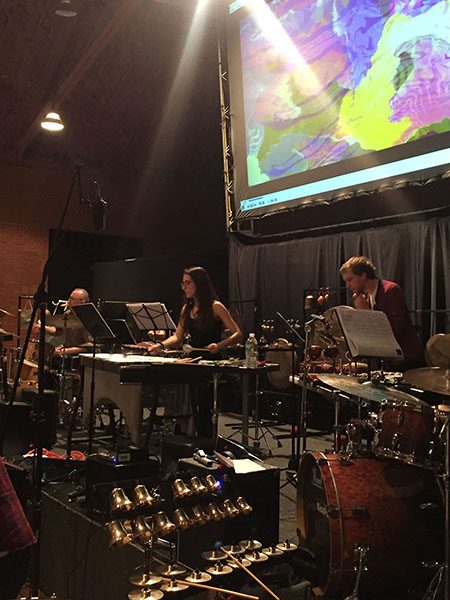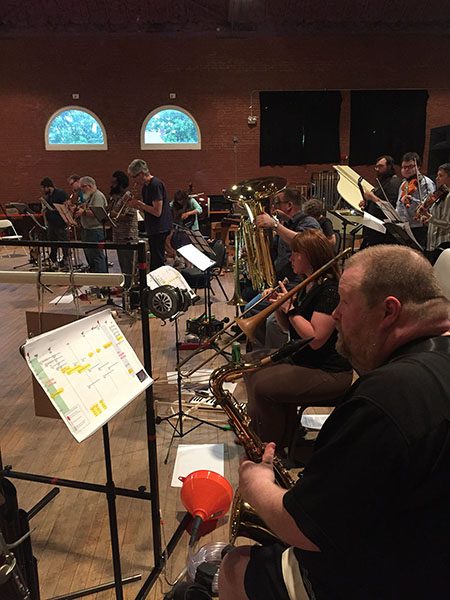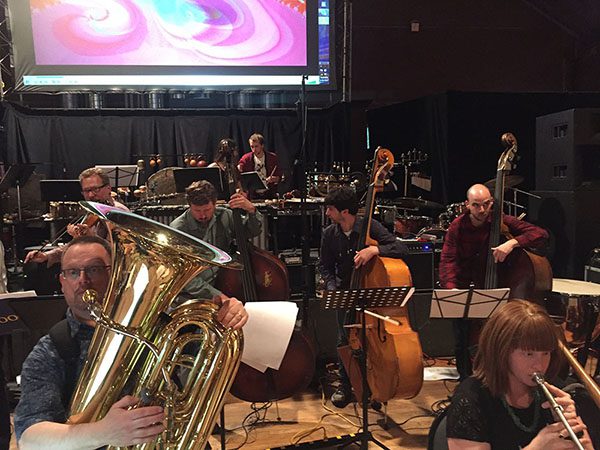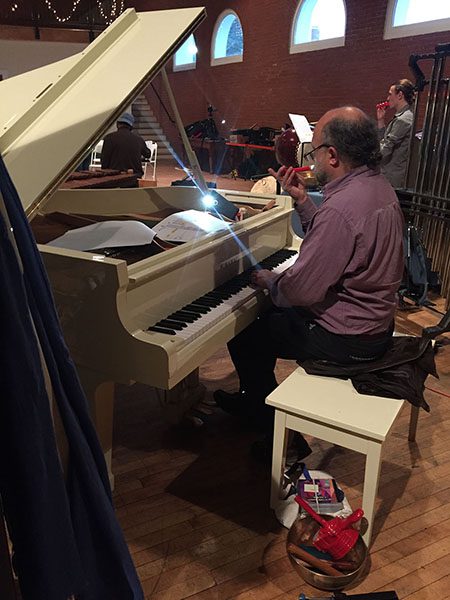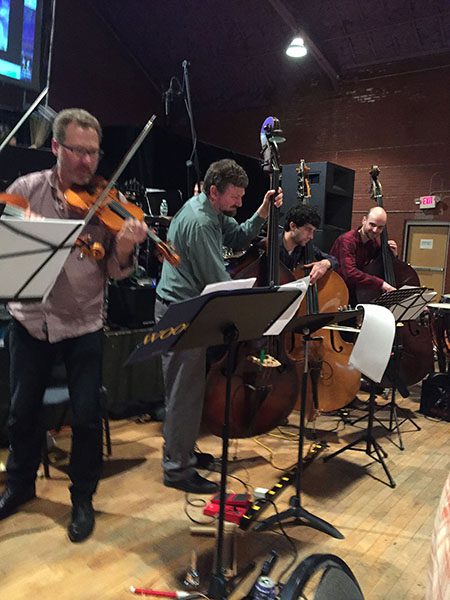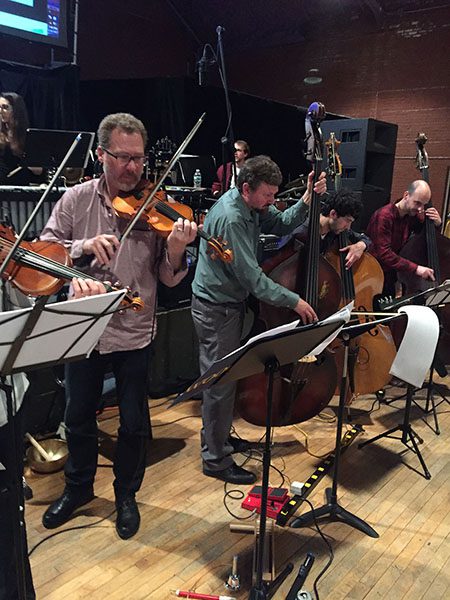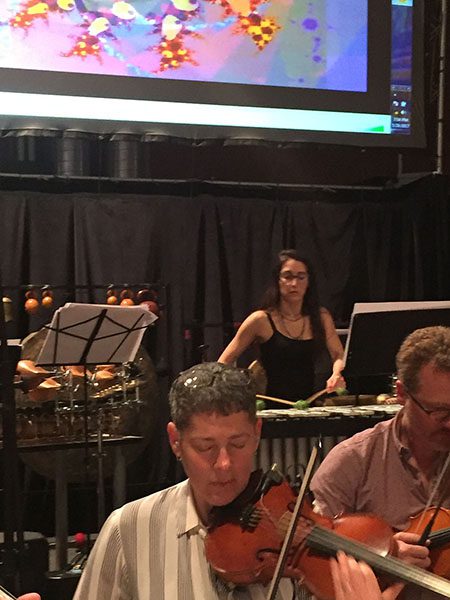Leap of Faith Orchestra
Graphic Scores by PEK
Possible Universes
Excerpt from Karl Ackerman Review
“… The Leap of Faith catalog has grown at a rapid pace in recent years; remarkable in that the collective and the enormous orchestra stay largely intact through these always complex works. Possible Universes works in a surprisingly paradoxical way, allowing structure and freedom to coexist, while constantly challenging the ear. It’s not quite like anything else.…”
Karl Ackerman, All About Jazz


Excerpt From Jazz Right Now Review
“… Some of what’s being played tears a page from traditional classical music while the rest of the material is highly experimental in nature. One of the guitar players is establishing melodic lines while the rest of the orchestra is trying to maintain its sanity. A lot of moving parts are in motion which makes the music fertile ground for even more new ideas.…”
Marc Edwards – Jazz Right Now
“… Started in 1995 as an interdisciplinary unit of improvisational artists led by Boston area reedist/multi-instrumentalist David Peck and cellist Glynis Lomon, exploring multi-phonics, glissando, microtones, graphic & descriptive scores, and extended techniques, expanding the ensemble with like-minded musicians, here in this 2017 recording of full 24-piece orchestra.…”
Squidco Staff

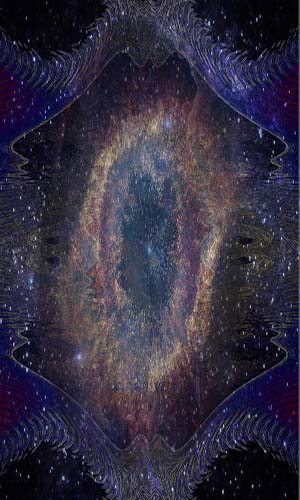
Excerpt from PEK Liner Notes
“… The scores use a device call Frame Notation where written English descriptions of the overall sonority desired and simple graphic symbols are given durations for each player on their part along with direction on when to play and when not to play. The directions are put in little boxes called frames which are arranged on a timeline and are simple enough to be immediately understood by the performers. The players track the elapsed time on a very large sports clock. There is no melodic, harmonic or rhythmic information specified.…”

Click on Image of Score
to View the Score

Click on Image of Program
to View the Program as pdf
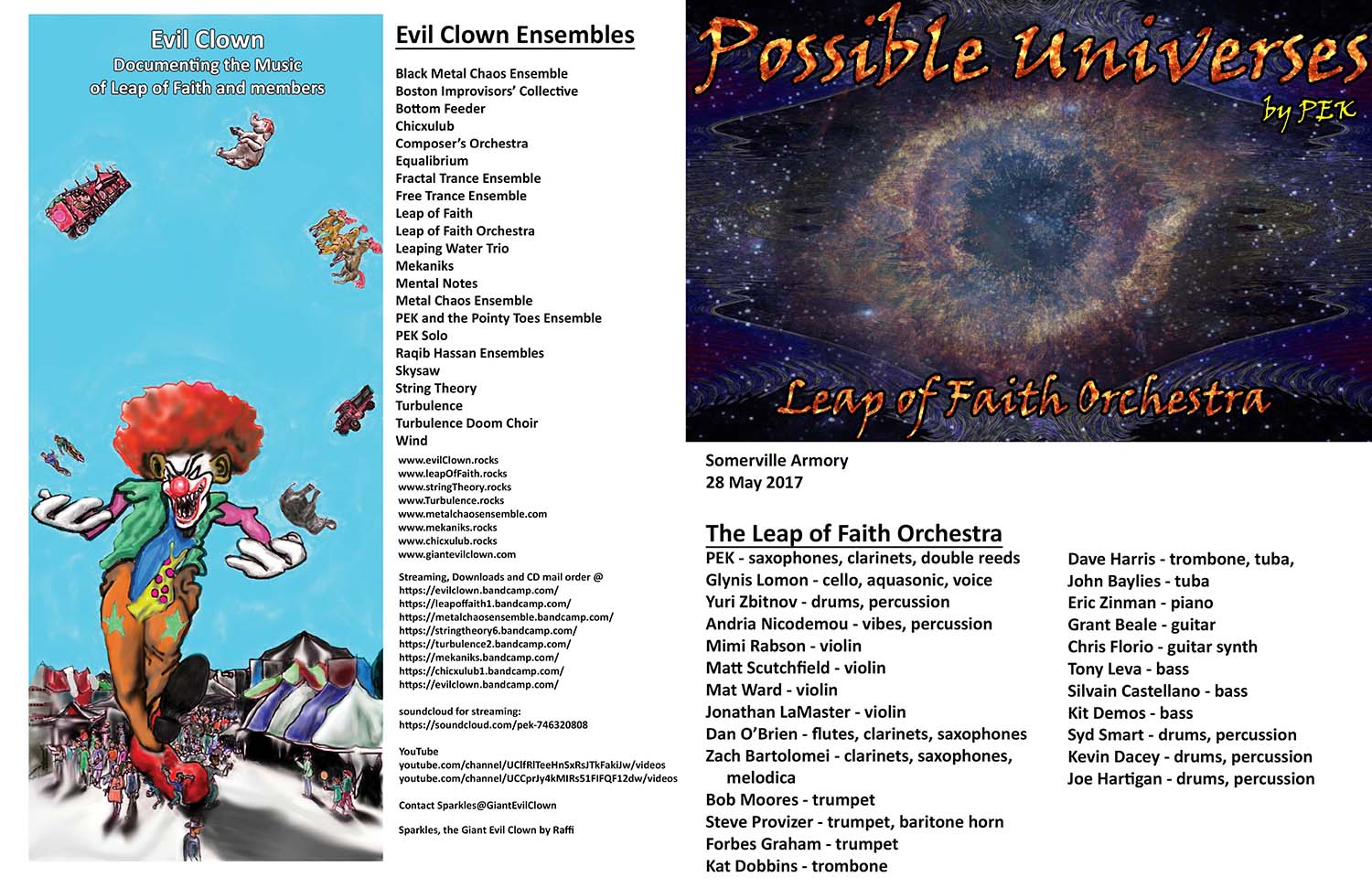

Possible Universes:
Leap of Faith Orchestra
Somerville Armory, Somerville MA – 28 May 2017
1) Leap of Faith Orchestra – Possible Universes – 1:17:02
PEK – saxophones, clarinets, double reeds
Glynis Lomon – cello, aquasonic,
Yuri Zbitnov – drums, percussion
Andria Nicodemou – vibes, percussion
Mimi Rabson – violin
Syd Smart – drums, percussion
2) Leap of Faith – Possible Worlds (download bonus track) – 20:26
PEK – saxophones, clarinets, double reeds
Glynis Lomon – cello, aquasonic,
Yuri Zbitnov – drums, percussion
Andria Nicodemou – vibes, percussion
Mimi Rabson – violin
Matt Scutchfield – violin
Jonathan LaMaster – violin
Dan O’Brien – flutes, clarinets, saxophones
Zach Bartolomei – clarinets, saxophones, melodica
Bob Moores – trumpet
Forbes Graham – trumpet
Kat Dobbins – trombone
Dave Harris – trombone, tuba
John Baylies – tuba
Steve Provizer – trumpet, baritone horn
Reverend Grant Beale – guitar, wood
Chris Florio – guitar synthesizer, wood
Eric Zinman – piano, kazoo, slide whistle, wood
Tony Leva – bass
Silvain Castellano – bass
Kit Demos – bass
Syd Smart – drums, percussion
Kevin Dacey – drums, percussion
Joey Hartigan – drums, percussion
Ensemble Auxiliary Instruments:
bullroarers, claves, melodicas, flex-a-tones, slide whistles, wind sirens,
crank sirens, bells, tibetan bowls, rachets, tube-o-phone
Bandcamp | Squidco | YouTube 1 | YouTube 2 | YouTube Shorties
Full Sets
Video Shorties
Possible Universes is the latest release from the multi-faceted Leap of Faith collective. In the orchestra formation, the group has released some half-dozen recordings but the “full” orchestra is a biannual occurrence where the normally fifteen-piece ensemble grows. On this album, the collaborative expands to twenty-four musicians and, as always, the long-time anchors are composer and reed player PEK (David Peck) and cellist Glynis Lomon.
As is often the circumstance in Leap of Faith Orchestra recordings, the album consists of one very long (almost eighty minutes) title track. The highly capable improvisers engaged by PEK are participating in the composer’s unique method of Frame Notation where (as he describes in the liner notes) ..,”written English descriptions of the overall sonority desired and simple graphic symbols are given durations for each player on their part along with direction on when to play and when not to play.” The notation looks more like playoff brackets but within are the only directions that the composer chooses to offer—the mechanics of “who” and “when.” What is not within the brackets are melodic or rhythmic data, placing Possible Universes in an often frenzied situation as the improvisations develop within controlled blocks of time and space.
Along with strings and three basses, a large assortment of percussion instruments, and two tubas, the orchestra utilizes an assortment of non-conventional devices such as bullroarers, claves, flex-a-tones, slide whistles, wind sirens, crank sirens, bells, Tibetan bowls, ratchets and a tube-o-phone. Even in the midst of scores of instruments, the piece utilizes silence as a much-needed balance. The Leap of Faith catalog has grown at a rapid pace in recent years; remarkable in that the collective and the enormous orchestra stay largely intact through these always complex works. Possible Universes works in a surprisingly paradoxical way, allowing structure and freedom to coexist, while constantly challenging the ear. It’s not quite like anything else.
Karl Ackerman, All About Jazz



Jazz Right Now Review
A beautiful gong begins the proceedings of Possible Universes creating the right mood for the improvisations. A solo violinist is playing away like mad, while rumbles from small percussion instruments: bells, wood blocks, and more, pepper the floor, making it difficult to get through this impassable field. This recording uses the full Leap of Faith Orchestra (LOFO). It has a multitude of musicians participating on this recording. This live performance was done on May 28, 2017, at the Somerville Armory. One day, I must get up to Cambridge and see this version of the LOFO in person or catch them live if they come to New York City. The full orchestra launches into a series of musical legato slurs that overtake the orchestra like a mutating virus, infecting bodily systems and internal organs along the way. This has the effect of producing screaming roars from the horns and other sections in the orchestra. I find myself thinking of the classical composer, Charles Ives.
With so much passion being displayed, I wonder how the audience must be reacting to hearing this body of polyphonics. This is the freest I’ve heard this orchestra. The music is very wild, off key, and feels like it’s operating more on pulse than traditional tempos. The feeling is very free from six minutes on, until, the gong reenters and shuts down this group improvisation; not permanently, but for this new section. The music ranges from low basses to piano explorations at the moment. The gong ends this section of loud dynamics. I thought this was over, but more loud sounds return briefly before entering a section of unintelligible vocals from the members of the orchestra. It sounds like they’re humming randomly. I once saw Frank Zappa and the Mothers of Invention do this at a show when they performed in Boston. The audience, however did not appreciate it and they began to leave the venue en mass!
The next portion of this composition, features crescendos, from horns, saxophones, and low rumblings from the bass section. I’m hearing the tuba also joining in the fray. Some of the sections are playing atonal lines, while others are improvising in between staccato lines. The driving drum rhythms from the percussion section is pushing the orchestra to another strata; a new plateau for more explorations. David Peck really knows how to utilize his musicians. One has to have a vision for having such a large orchestra. Some of what’s being played tears a page from traditional classical music while the rest of the material is highly experimental in nature. One of the guitar players is establishing melodic lines while the rest of the orchestra is trying to maintain its sanity. A lot of moving parts are in motion which makes the music fertile ground for even more new ideas. The tuba joins the bass section as they contribute melancholic lines that support the mayhem on top. This is the root and foundation for the orchestra, allowing it to continue to move and explore new vistas at will.
Marc Edwards, Jazz Right Now

Excerpt from PEK Liner Notes
Possible Universes is my third Graphic Score for large improvising orchestra since 2015. These very special full orchestra events occur only twice a year. For each performance I prepare a Graphic Score specifically for that event which is simultaneously a Density and Sonority map prescribing the improvised development of the work.
The scores use a device call Frame Notation where written English descriptions of the overall sonority desired and simple graphic symbols are given durations for each player on their part along with direction on when to play and when not to play. The directions are put in little boxes called frames which are arranged on a timeline and are simple enough to be immediately understood by the performers. The players track the elapsed time on a very large sports clock. There is no melodic, harmonic or rhythmic information specified.
This system allows me to compose detailed Events without having to notate pitches or rhythms which would require significant rehearsal to accurately achieve. Skilled improvisers, like the ones I have recruited, can easily follow these instructions to create a highly structured improvisation without the need for specific rehearsal even when the ensemble is quite large as it is here. This allows enormous freedom and decision making for each performer and means that we do not have to rehearse these pieces prior to performance.
All of the other contemporaneous Evil Clown performances and recordings by all of the ensembles – Leap of Faith, String Theory, Turbulence, Mekaniks, Metal Chaos Ensemble and the Sub-Units – are preparation for these full Leap of Faith Orchestra performances. The performances by these sub-ensembles stand by themselves as improvisation records as well as getting us ready to improvise in a full orchestra setting.

Raffi Photos



